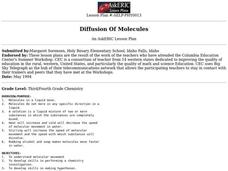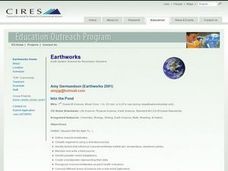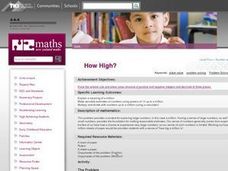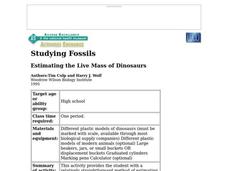Curated OER
Look at Those Leaves!
Students research tree leaves. In this tree leaves lesson, students observe, measure, and sort tree leaves. Students examine leaves individually, in groups, and in relationship to the entire tree.
Curated OER
Finding a Difference
Students find a small difference by counting up from the smaller to the larger number. They count the ones that don't match, lay them horizontally to match them to the orientation of the number line and show the two numbers on...
Curated OER
Diffusion of Molecules
Learners study the process for diffusion of molecules. In this chemistry lesson, students understand molecular movement, develop skills for a chemistry investigation, develop skills in making hypotheses, develop observational skills, and...
Curated OER
DENSITIES OF REGULARLY SHAPED SOLIDS
Students calculate the volumes of regularly shaped objects from measurements of their dimensions. They use several formulas and measure different objects to calculate the density, volume, and mass of the objects selected or assigned.
Curated OER
SLIME!
Young scholars learn the effects of friction and examine how certain lubricants can only be used with certain materials.
Curated OER
Diffusion Of Molecules
Young scholars investigate molecular movement while studying how to perform a chemistry investigation.
Curated OER
Melting and Freezing
Fifth graders observe experiments with ice and water. They complete a Venn diagram listing the properties of each. They experiment with ice and water, comparing their weights. They note the weights are equal.
Curated OER
You Can Be a Woman Engineer
Pupils inspect a variety of objects from different points of view. The front, right, side, top and bottom. They then draw a diagram of that object from the point of view chosen. Also, they think of other objects and draw them from...
Curated OER
Ordering Objects By Length
Students compare and describe objects of differing lengths that are presented in a Mathkeys software compare mat. Working in pairs, one student is the chooser who sets up the objects while the other student is the sizer who puts the...
Curated OER
Penguins and Their Habitats
First graders research and observe penguins in their natural habitats. They conduct Internet research, complete a penguin WebQuest, and compile information on a selected type of penguin. Using their research information they create a...
Curated OER
Present Hunt
In this game students move around a game board by spinning a spinner and moving to the next place on the board whose shape matches the one they spun.
Curated OER
Sink or Swim
Students define density and explain how to determine the density of an object. Students participate in a demonstration that shows the differences in the densities of different liquids and how they affect the liquid's physical properties.
Curated OER
Making Layered Hail Stones
Students explore how hail forms in the atmosphere, why hailstones are layered, and what accretion is. They also learn what supercooled liquids are.
Curated OER
Physical Difference and Classification
Students use a microscope and observation skills to compare and contrast several physical properties and develop a classification system.
Curated OER
Marble Game
Students practice counting groups of items of six or more. They create equivalent sets.
Curated OER
Awareness of Pre-algebra Concepts
Students work in a cooperative group of three to solve algebraic equations with roles assigned for manipulator, recorder, and checker. They utilize hands-on learning materials imbedded in the lesson plan.
Curated OER
Into the Pond
Seventh graders use a pond to explore macroinvertebrates and other organisms. They use a dichotomous key to classify the organisms and maintain a journal recording their findings.
Curated OER
Fruity Counters
Students classify objects that are similar by one attribute. They explain what a pattern is and how to make a pattern using objects.
Curated OER
Drink It Up!
Students investigate how the human body needs water by recording their water consumption for a day. They sing a song about drinking water, make and drink Kool-Aid and eat apple slices, and conduct an experiment to determine how much...
Curated OER
How High?
Fourth graders play an estimation game to guess how sheets of paper are in a pile and then guess who high a stack of one million would be. They work in small groups to explore ideas for working out how high the stack would be.
Curated OER
Penny's Box
Students need to be able to calculate the volume and surface area of a cuboid as well as present a systematic list of results in order to justify the minimum case. The use of three factors of 100 is also important.
Curated OER
Richard's Dice
Students problem solve logic problems. They complete a worksheet using dice as a manipulative. They decide on a problem solving strategy, solve the problem, and write up the solution.
Curated OER
Estimating the Live Mass of Dinosaurs
High schoolers calculate the volume of scale model dinosaurs using a water displacement method. They use formulas to calculate the live mass each of the species of dinosaur. Then they complete and discuss a series of questions.
Curated OER
Estimating the Live Mass of Dinosaurs
High schoolers estimate the live mass of dinosaurs. Using dinosaur and modern animal models, students use simple displacement methods to calculate the volume of the models. They calculate the masses of each model. High schoolers...
Other popular searches
- Writing Cubing Activities
- Cubing Activities English
- Cubing Activities as Review
- Cubing Activities in Health

























